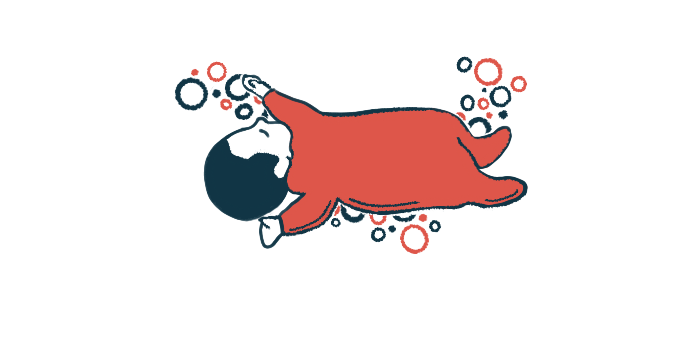No significant gains seen with SMA type 1 dual therapy in real world
Adding Spinraza or Evrysdi to Zolgensma did not prevent disease progression
Written by |

Following treatment with gene therapy Zolgensma (onasemnogene abeparvovec-xioi), adding a second therapy, such as Spinraza (nusinersen) or Evrysdi (risdiplam), did not prevent widespread muscle disease progression in infants at risk of spinal muscular atrophy (SMA) type 1, a real-world study found.
Although children treated with a combination therapy sat up about six weeks earlier than those given Zolgensma alone, walking age and signs of muscle abnormalities were similar over follow-up regardless of the use of mono or dual therapy.
“We will continue to follow these children over time to determine if and how combination therapy improves functional outcomes in patients at risk for type 1 SMA to best guide clinical management for them,” Karlla W. Brigatti, a study author and the research director at the Clinic for Special Children in Pennsylvania, said in a press release.
Titled “Preemptive dual therapy for children at risk for infantile-onset spinal muscular atrophy,” the study was published in the Annals of Clinical and Translational Neurology. While the study was not funded by Novartis Gene Therapies, Zolgensma’s developer, two of its authors served as paid consultants for the company.
The researchers summed up their findings by noting that “preemptive dual therapy … may provide modest benefit for children at risk for severe spinal muscular atrophy but does not prevent widespread degenerative changes.”
Study is first to compare children given monotherapy vs. dual therapy
In SMA, mutations in the SMN1 gene lead to a deficiency in the SMN protein, resulting in symptoms such as progressive muscle weakness and atrophy. SMA severity correlates with the number of copies of a second SMN2 gene. Children with two or fewer SMN2 copies develop more severe disease within a few months after birth.
Zolgensma is a one-time SMA gene therapy designed to replace the defective SMN1 gene. Spinraza and Evrysdi, also approved treatments, both work by increasing the production of the SMN protein. All three work best when administered before the onset of muscle weakness.
Some children treated with Zolgensma early in life are later prescribed Spinraza or Evrysdi due to progressive weakness. However, whether this practice is effective is difficult to judge because children receiving Zolgensma alone — as a so-called monotherapy — have not been directly compared with those treated with both Zolgensma and Spinraza, or Zolgensma and Evrysdi, as a dual therapy.
To address this gap, researchers at the Clinic for Special Children, alongside colleagues at the Children’s Hospital of Philadelphia, compared the efficacy of monotherapy to dual therapy given within six weeks after birth to presymptomatic children at risk for infantile-onset SMA type 1.
According to Brigatti, “this study is the first to compare children receiving early monotherapy or dual therapy in SMA, addressing an important question for the patient community in a real-world setting.”
The team followed 23 infants who received preventive therapy within six weeks of birth and before the onset of symptomatic weakness. Among them, 18 had two copies of SMN2. Of these babies, 11 received monotherapy and seven dual therapy. The decision to add a second therapy was made between parents and/or caregivers during routine clinical management.
Five children with three copies of SMN2, who were expected to develop SMA type 2, received only the gene therapy.
All of the youngsters were followed for a median of three years. The study’s primary outcomes were independent sitting and walking.
SMA type 1 children have similar walking age, muscle abnormalities
Each of the five children with three SMN2 copies who were treated with Zolgensma alone sat and walked independently within normal reference ranges.
Among those with two SMN2 copies, all but one (17, or 94%) sat independently, and 15 (83%) reached this milestone within the normal timeframe of 9.2 months or less. Nine children (82%) were given monotherapy and walked, compared with six infants (86%) who were given dual therapy. Of these, nine walked before the age of 17.6 months, the upper normal limit. The only non-walker receiving dual treatment was 14.8 months of age at follow-up.
Children with two SMN2 copies treated with monotherapy sat about six weeks later than those with two copies treated with dual therapy and those with three SMN2 copies. Sitting age was similar between the two-copy dual therapy and three-copy monotherapy groups. Children with three SMN2 copies walked earlier than both two-copy groups, with walking age similar among those with two copies, regardless of mono or dual therapy.
Our data suggest that preemptive dual as compared to monotherapy is well tolerated by children at risk for infantile-onset SMA 1 but may provide limited if any additional benefit.
Function abilities before treatment did not predict the motor outcomes among children with two SMN2 copies, the data showed.
Within 60 days after birth, muscle ultrasound measurements were normal in nearly all cases (91%). By the three- to 61-month (or about five-year) mark, however, most showed abnormal fat infiltration and involuntary rapid muscle twitches, known as fasciculations, in at least one muscle group. These changes were indistinguishable between monotherapy and dual therapy groups. Those with three SMN2 copies had essentially normal muscle ultrasounds.
No treatment-related adverse events were reported for dual therapy children, and 11 patients who completed sensory testing, including six on dual therapy, had normal sensory responses.
“Our data suggest that preemptive dual as compared to monotherapy is well tolerated by children at risk for infantile-onset SMA 1 but may provide limited if any additional benefit,” the researchers concluded.








